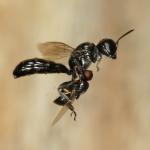Crabro bidens (HALIDAY,1833); Crabro bison (COSTA,1884); Crabro laeviceps (SMITH,1856); Crossocerus leucostoma misident.; Coelocrabro leucostomoides (RICHARDS,1935); Crossocerus niger LEPELETIER & BRULLÉ,1835; Crossocerus rufipes LEPELETIER & BRULLÉ,1835; Crabro zaidamensis (RADOSZKOWSKI,1887)
Richards (1980) states that it is common throughout the British Isles. However, current records show that it is very thinly distributed in Scotland and with only a few east coast sites in Ireland. Also present on the Isles of Scilly, Guernsey and Sark. Lomholdt (1984) considered the species to be widespread in Europe, although generally missing from the Iberian Peninsula, the Balkans and Asia minor. It has also been recorded from north Africa, Iran and northern Japan.
This species is not regarded as threatened.
May be recorded from a wide range of habitats where its nesting substrate can be found. Captures from Essex include a suburban garden, dead elms on an estuarine island and a dead, fallen tree trunk in an otherwise closely mown recreation ground.
Current data span from mid-May to mid-September, but most records come from June to August, inclusive.
This wasp appears to have a very catholic taste from within the Diptera families.
C. megacephalus nests gregariously, utilising mainly old beetle borings in dead and decomposing wood (Richards 1980). Lomholdt (1984) notes that both deciduous and coniferous wood may be utilised, as might the old larval galls of the Cerambycid beetle Saperda populnea L. It is apparently not uncommon for females to share the same entrance hole, but construct essentially independent systems that might inadvertently intersect each other.
No information is available.
Lomholdt (1984) lists the Ichneumonid wasp Endasys analis (Grav.)[a Continental species], the Pteromalid wasp Habritys brevicornis (Ratzeburg) and the Anthomyiid fly Eustalomyia festiva (Zett.).
2019







